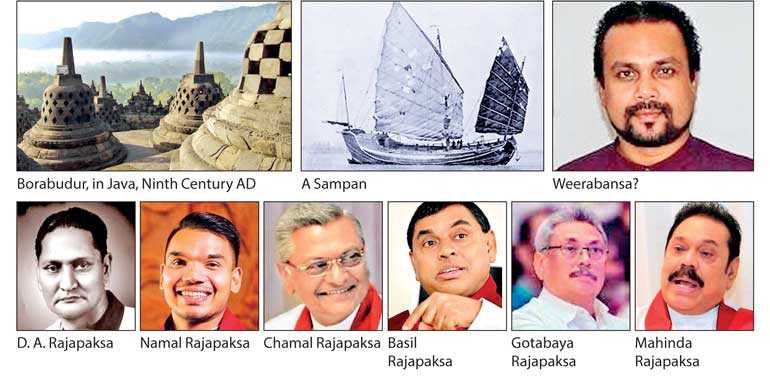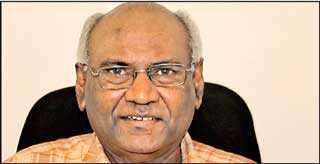Wednesday Dec 11, 2024
Wednesday Dec 11, 2024
Monday, 8 March 2021 00:00 - - {{hitsCtrl.values.hits}}

Kantharodai – from the Period of Tamil Buddhism. (Only the bases were there when I saw these as boy. The top is Archaeology Dept. imagination like Sinhala Brahmi


By S. Ratnajeevan H. Hoole from Java Pattinam
 The struggle with heritage histories
The struggle with heritage histories
My book Heritage Histories shows, definitively I believe, that our histories are all hocus pocus with a view to showing how great a people we are. We (or many of us) claim to be a pure race of ‘Aryans’ but
occasionally, Mongol and Negroid features show up in our families. We claim to be high caste, but the occasional pinky skin, dark pigment, high cheekbone or crinkly hair tells us that all is not well and we are of mixed genes.
Likewise, those Sinhalese claiming to be Govi Buddhist Sinhalese struggle with blue eyes, very white skin and concocted histories about being descended from pure Sinhalese Vijaya stock (Brahmin vaagay, they proudly say); they are embarrassed only when a newborn is as dark as a South Indian or has Australoid features. Paraphrasing Gananath Obeyesekere, our light complexions and blue eyes are not from the ancient Aryan invaders but from our latter-day invaders. Muslims need to outlive their claims of being Arab and explain why most of them look no different from Tamils and can weakly point to occasional Arab features like tall height, green eyes, etc., as in their ruling families.
Choice
Our heritage histories are concocted to make us superior, but we all repeat them. We can subscribe intellectually to world views and religions, but cannot deny that our gene pool has many strands when Andaman and hunter-gatherer features show. How nobly we live is what matters and it is based on choice.
Cardinal Malcolm Ranjith’s position against religious conversion, coming from a person whose ancestors converted and whose Church is founded upon sharing the ‘good news’, is the most disgraceful retreat from principle.
It is dishonest, too. Buddhist missionaries came here to share what they thought was a superior faith – just as Christian Missionaries did. Today, the Sai Baba folk do the same. Choice is fundamental to our democratic way of life.
We, who are inheritors of many strands of culture and genes, should be the most welcoming of the competition of ideas and faiths.
Hassan Shazuli
As religious conversions take centre stage in our debates, I was pleasantly surprised to see Hassan Shazuli hosting a discussion on NewsFirst with Colombo University Malay academic Tuan Zameer Careem (who also goes as Zameer Careem Khan of partly Afghan descent). These name changes suggest that he is also struggling with his different strands of pedigree.
He need not because he is well-read, widely informed, articulate, brilliant, and comes across better than most academics here I know.
The Malays
As evident from the title of the program, ‘The Valiant Malays of Ceylon: Lost and Forgotten’, it was about Malay history. It describes the rich contributions of the Malays to Sri Lanka. Zameer Careem explains that only a few of the Malays are from Malaya. Although he says the Malays have been here from time immemorial, he gives a late date for their entry when he gives Chandrabanu Dharmaraja, a Malay Buddhist Javaka king, who made a military incursion in 1247 AD with ‘Malay’ soldiers. The majority came from Indonesia, first under the Portuguese and then under the Dutch, as both soldiers and slaves.
Careem says the Dutch used the term ‘Austranesian ethno-linguistic group’ (that is how I heard it, but it does not show up in searches) to distinguish Malays from other peoples, I take it of brown skin like them but racially different. It was the British who first began calling them Malay, presumably because they ruled Malaya and knew them as Malays while the Dutch held Indonesia.
Colombo, says Careem, was 50% Malay in the seventeenth century because of the vast cinnamon plantations in what is now Cinnamon Gardens, perhaps the most expensive residential area in the country today.
There were 4000 Kaffir (African) slaves building Colombo Fort. As far as I know, they had no families. Did they sire no children? Are the Mongol and Negroid features that come up among us not from these times and a positive contribution to Sri Lanka?
Cultural contributions
It is widely believed that mixing gene pools leads to higher intelligence in people. While the Dutch slaves (and indeed slaves brought in from South India for tobacco cultivation and cinnamon gardens) contributed to our intelligence, they made cultural contributions too.
Careem mentions the shell comb worn by the Sinhalese, the sarong that all of us wear, kite flying, batik print, ‘beeralu lace-making’, dodol, nasi goreng (literally rice-fried), and rambutan (Malay for hair is rambu) as their contributions.
Careem also claims that Vettil Appam (the jaggery coconut pudding) means vattamaanana (round) appam. I need to disagree here because in ancient Tamil, vattil is a plate – pudding on a plate, the way Vattil Appam was invariably served until restaurants took it over. How Careem pronounced vattamaana was so natural. I take it that he is as fluent in Tamil as he clearly is in English. I do contest the origin of Vattil Appam as being Malay because of the use of ancient Tamil in the nomenclature.
I also am sceptical of his placing Kandarodai temples in parallel with the 9th Century Borobudur temples in Java when Chandrabanu Dharmarajah ruled Jaffna in the 13th Century AD, as he says. Though similar in appearance, Kandarodai hails much earlier from Tamils’ Buddhist times (from the 2nd Century BC up to Manimehalai, which is no later than the 5th Century AD).
This was also the time, says Careem, Jaffna came to be called Java Pattinam. A 1619 AD Portuguese era map calls Jaffna ‘Jafna Patnam’. Philippe de Oliveira who moved the capital from Nallur to Jaffna around 1619 AD called it Jaffnapatão. I believe Careem errs in saying the name Jaffna is from Java Pattinam. In1614 AD, we see the name statue of ‘Our Lady of Miracles, Jaffna patão’. The kind of ão, as in pão for our bread, is pronounced with a soft ‘n’ at the end (paan), obviously making patão to be pronounced as pataan, a corruption of pattinam.
Careem’s arguments are weak, similarly, when he says it was during Chandrabanu Dharmaraja’s period that Thavasi Kulam came from Java Kulam, and likewise Java Thoppu, and Java Kottai. He needs to explain how Java got twisted into Yaalpaanam, Thavasi, etc.
Tackling heritage histories
People whose power is based on heritage histories, react violently when that history is questioned. A long-serving Malaysian Prime Minister, known popularly as ‘The Little Indian’ was the offspring of a Malayali Butcher and a Malay woman. A reporter doing a story on it, it is reported, disappeared.
Similarly, a relation of mine was tutoring a princess and married her after getting converted to Islam. He was sent to Saudi Arabia for four years of training and pulled off calling himself a Saudi because he was tall and light-skinned. When his brother (our grandfather) saw him on the street and went up to him, the brother was signalled to go away. When the granduncle died, there was a terse letter to our grandmother ‘From the Palace’ stating so – the first communication after the marriage.
In my time, the son had become Prime Minister of Malaysia. When the family tried to make contact, his staff told the family not to speak of the matter again, but thankfully were not disappeared! Such is the stranglehold of heritage histories, especially when being elected depends on cooked up histories.
Shifting to Careem, he said nutmeg was brought here by the Dutch from an island called Banda. When the Banda folk rioted, many were executed, and the remainder brought here as prisoners. Some escaped and fled to Kandy where the king was hospitable. These Malays gave us the Bandas.
More sensitively, Careem says the Weerabansa surname is from Malaya.
Explaining the Javanese influence in Hambantota, Careem said Sampanthot is from Sampan (boater’s gift) plus Tot. I believe it comes from Tamil. Many Tamil words beginning “ch” have it turned to “h” in Sinhalese. Examples are sothi or chothi (yellow gravy) to hothi; and santhi or chanthi (junction) to hanthi. So the Malay word for champan or sampan, a boat, absorbed into Tamil, becomes hampan in Sinhalese, and combined with thottam (garden) makes Hambanthota. This is what Tamils say.
In Hambanthottai, with its huge Malay influence, we can easily discern the genes turning up in so-called Govi-Sinhalese Buddhists. Given the history of Hambanthota, these must be from Malays. The unlikely alternative is that these genes are from the Andaman and Nicobar islands pictured at the top who have also a unique unnamed DNA sequence (from a third hominid – vide Nature India, 30 January 2017).
There is no problem at all if there are all kinds of genes in us. We really have no choice in that. Some of us go to worship in churches, mosques, temples and viharas. We do have choice but our choice is ours to make.
The problem is when people with all kinds of genes and going to churches, mosques, temples and viharas as multiple insurances with the gods keep repeating that this country is only for Sinhalese Buddhists; even then, they will not vote for a non-Govi.
How great an opportunity it would be if those of us with mixed genes and worshipping all kinds of gods would say so, and that in this country, our race does not matter and that we have full choice in whom we worship or in not worshipping at all. That is the only way to make Sri Lanka great again.